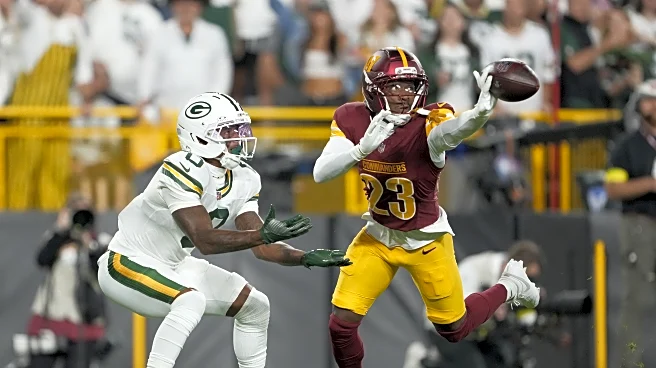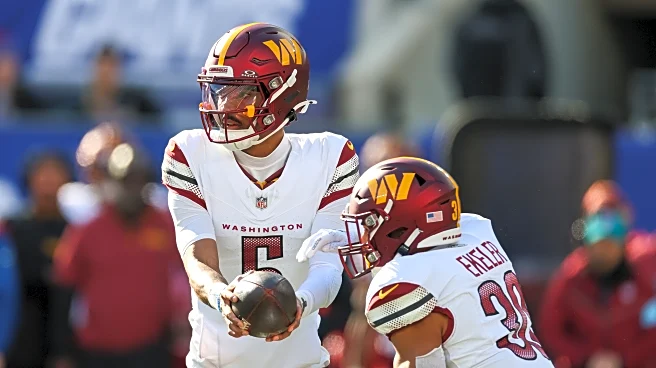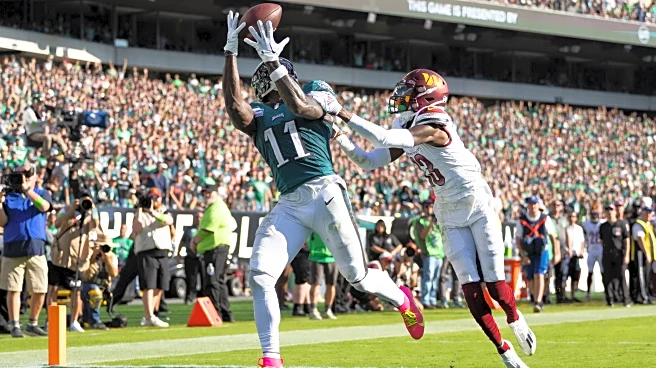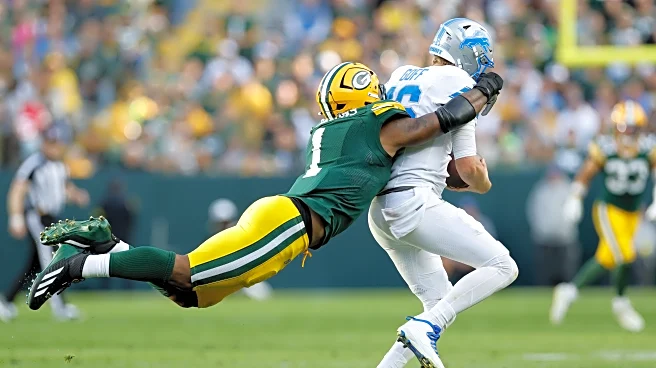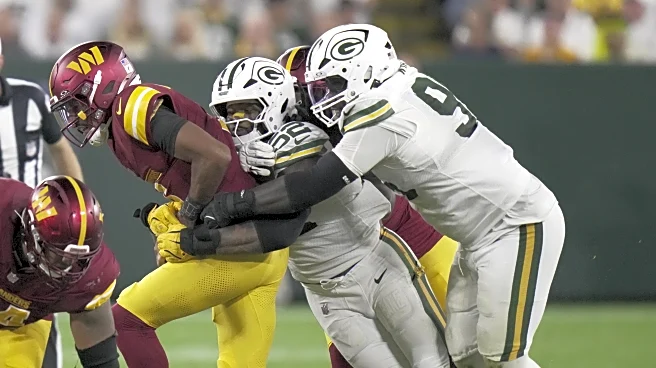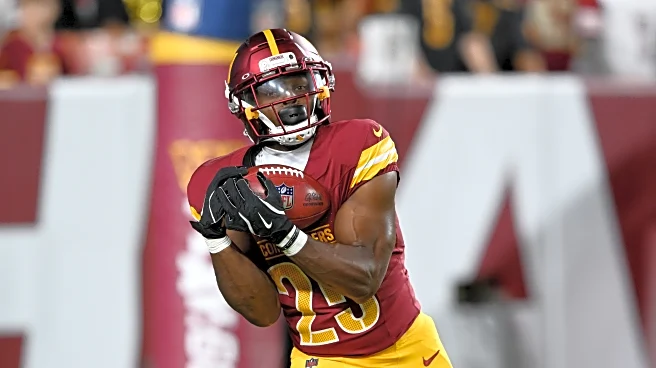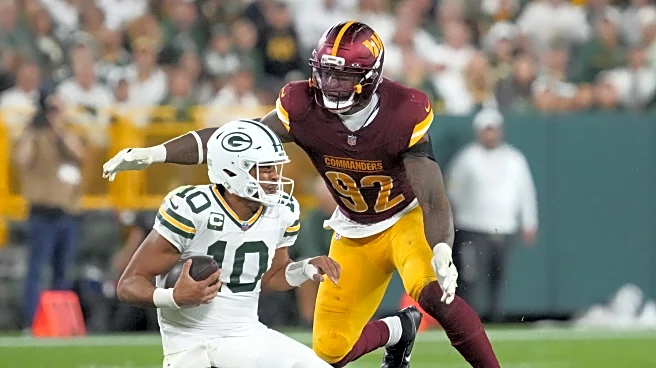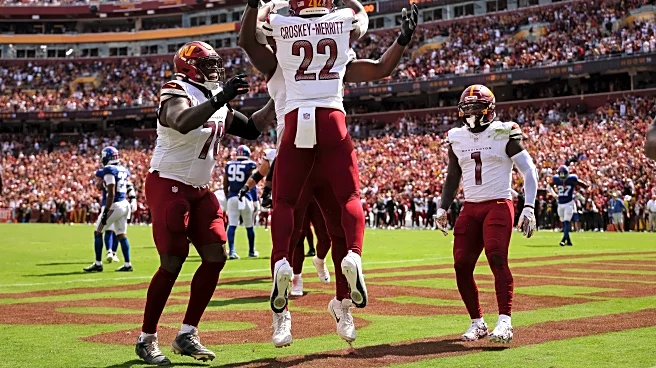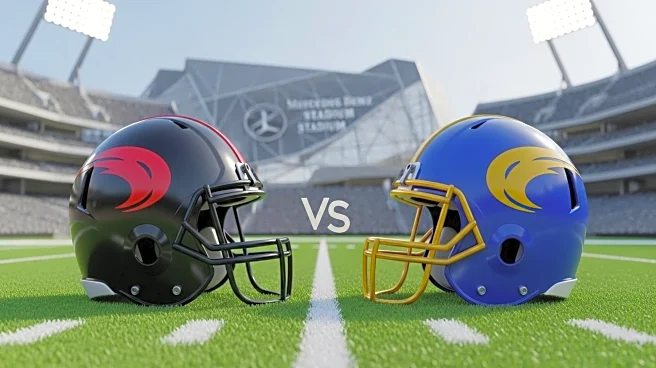The Commanders coasted through Week 1 with a win against a struggling Giants team despite not playing their best. Thursday night’s primetime matchup with the Packers provided a reality check.
The Commanders struggled in practically all aspects of their game, against a surging Packers squad. Even so, there were a few bright spots, including punting, returns and coverage on special teams and a few solid individual performances on offense and defense. The Commanders struggles to execute were compounded
by injuries to key starters which could have reverberating effects for the rest of the season.
The failure of the run game was baffling and undermined the entire offense. Facing the Packers’ dangerous pass rush, Kliff Kingsbury made the odd choice to abandon the run from the outset. In the first quarter, the Commanders ran just 2 rushing plays. When they did start turning to the run near the end of the second quarter, their two best run blockers had been hobbled by injuries. As a result, the RBs averaged just 0.58 Yards Before Contact/Attempt, compared to 3.0 YBC/Att the previous week against the Giants.
Perhaps the most curious decision was the choice to lean on Austin Ekeler as the lead back on interior runs, rather than using Bill Croskey-Merritt or Jeremy McNichols, who are better suited to running between the tackles. The rushing attack averaged just 2.7 Y/A and did little to take the load off of Jayden Daniels, who took a beating from the pass rush behind a weakened offensive line, to the tune of 4 sacks and 12 QB hits.
Injuries to Daniels, Ekeler, DE Deatrich Wise Jr, TE John Bates, WR Noah Brown, CB Jonathan Jones and LG Brandon Coleman are likely to have a major impact on the Commanders’ upcoming games, and possibly the rest of the season.
The front office and coaching staff have their work cut out for them, patching the team up to face the Raiders, and fixing the vulnerabilities which were exposed by the Packers. But despite the setbacks, the team still has some key strengths to build around, including a few players who stood out on Thursday night. Let’s see who got playing time, who stood out and who took a step back in last week’s 18-27 loss at Lambeau Field.
OFFENSE

Jayden Daniels hasn’t looked like himself since the season started. In Thursday’s loss to the Packers, he completed just 57.1% of passes for 200 yds and ran for just 17 yds on 7 attempts (2.4 Y/A), which was good for a 27.8 QBR, the third lowest of his career after last year’s regular season loss to the Eagles (18.8) and the season finale against Dallas (16.7). He was sacked 4 times for 21 total yards, took 6 hits (up from 1 last week) and experienced pressure on somewhere between 25.0% (Pro Football Reference) and 48% (PFF) of dropbacks, according to different stats services’ scoring systems.
Sticking with PFF, the increase in sacks and hits this week coincided with a 2.5x increase in total pressures from last week. Jayden’s Pressure to Sack rate actually dropped from 30% against the packers to 16% in Green Bay. But the improvement in avoiding pressures was not enough to compensate for the volume of pressures he faced, particularly coming through the right side of the offensive line.
Late in the fourth quarter he came up limping, and after the game it was reported that he had an MRI on his knee. We won’t know if Daniels will play against the Raiders until Friday, at the earliest.

The best way to protect a QB is with a strong running game. One of the more baffling aspects of the game plan in Green Bay was abandoning the run early on, and then turning to Austin Ekeler as the lead back, when better options were available. The Commanders ran just 19 times vs 42 pass attempts, in stark contrast to the Packers’ 30:31 run/pass balance. When they did start running more around half-time, the RBs got little help from their blockers, with LG Brandon Coleman slowed by a shoulder injury and TE John Bates out with a groin injury.
Ekeler ran for just 17 yds and 2 first downs on 8 attempts (2.1 Y/A). He had little room to run, averaging just 0.25 Yards Before Contact/Attempt, and only managed to pick up 1.9 Yards after Contact per carry. Curiously, the Commanders chose to run him through the A gaps on 5/8 attempts, where he averaged just 2.8 Y/A. He was equally ineffective as a receiving target, catching 2/4 passes for 7 yds, before leaving the game with an Achilles tendon injury.
Bill Croskey-Merrit also ran for 17 yds, but on half the number of carries. He did not find the going much easier on his 4 touches, averaging just 1.25 YBC/Att, but managed to gain an average of 3.0 YAC/Att. He was targeted once as a receiver, but the ball was thrown behind him and he was unable to bring it in.
Jeremy McNichols was mainly used as a receiver, running routes on 15/16 offensive snaps, but was not targeted. Another curious choice.

This week Terry McLaurin led the WRs, with 48 receiving yards. Developing the connection with JD5 remains a work in progress, as he has maintained a 50% reception rate through the first two games. His reception and yardage totals went up this week because his targets increased from 4 to 10. This week, he caught 2/2 contested targets. He has not dropped a pass yet this season. His receiving productivity at 0.93 Yards/Route Run is way down through two games compared to last year’s average of 1.97 Y/RR and his career average of 1.85 Y/RR.
Deebo Samuel was close behind Terry at 44 receiving yds, 2 first downs and 1 TD. He caught a perfect 7/7 targets, but had a much more manageable -1.6 yd Average Depth of Target than Terry at 12.8 yds. Samuel led all Washington receivers with 7.9 YAC/Rec and 5 forced missed tackles according to PFF.
Luke McCaffrey caught his first two passes of the season and found the end zone for the first time as a Commander. The official records show 1 reception on 1 target for 19 yds. The second reception was a 2 point conversion, which are not kept as official league stats. Luke was wide open on both receptions. Last season, Luke had the fifth highest rate of routes with separation in the league at 71.6% (min 65 opportunities). Hopefully he will keep getting opportunities and JD5 will see him more as the season progresses.
Noah Brown caught 1/4 targets for 9 yds. Jaylin Lane caught 1/3 for 2 yds.

Zach Ertz led all Washington receivers with 64 receiving yards and 1 TD, and a 144.3 Passer Rating when targeted. He caught 6/7 targets (85.7%), including his only contested target, at an ADOT of 6.3 yds. He was the Commanders’ third most productive receiver at 1.42 Y/RR.
John Bates left the game with a groin injury in the second quarter and did not return. His absence was felt in the running game and pass protection.
Ben Sinnott caught his first reception of the season for 7 yds. That made him the Commanders’ most productive receiver at 2.33 Y/RR, since he was only on the field for 3 offensive snaps. Luke McCaffrey was in second place at 1.58 Y/RR.
Colson Yankoff played 1 snap on offense, uneventfully.

The offensive line took a relentless beating by the Packers’ defense featuring Micah Parsons and the lesser known Devonte Wyatt. In fact, just about everyone got in on the action, with 10 Packers’ defenders registering at least one QB pressure according to PFF. The right side of the OL was hardest hit, with Nick Allegretti and Josh Conerly accounting for 63% of the total OL pressures and all of the sacks.
LT Laremy Tunsil held up reasonably well, allowing just 2 hurries and 1 QB hit in 56 pass blocking reps. His 5.4% Pressure Rate allowed is around median for NFL starters. His main problem was really the volume of passing attempts. If a team runs enough passing plays, eventually pass rushers will get to the QB. Last season the Commanders averaged 28 passing attempts per game. Keeping a QB clean on 56 dropbacks is a lot to ask from any OT. Tunsil’s 48.8 PFF Run Block grade was much lower than last week (71.5).
LG Brandon Coleman left the game in the second quarter with a shoulder injury, and was replaced for 11 offensive snaps by Chris Paul. His injury significantly impacted the OL’s overall blocking performance. Coleman allowed 4 pressures including a QB hit in 48 pass blocking snaps (8.3% Pressure Rate), which was a sharp drop off from his perfect performance in Week 1. Ironically enough, PFF rated his run blocking better this week at 71.3. However, that was not reflected in the RBs’ YBC figures through the left interior gaps as previously discussed.
PFF credited C Tyler Biadasz with just 2 QB hurries, which would be pretty good for 56 pass blocking snaps (3.6% Pressure Rate). But he seems to have got away with 1 QB hit, which PFF must have attributed to Nick Allegretti:
His adjusted pressure rate of 5.4% is pushing the limit for a center. PFF gave him a decent 61.3 run block grade.
RG Nick Allegretti gave up 6 total pressures, including a sack and a QB hit (10.7% Pressure Rate). Even giving the hit back to Biadasz doesn’t make that look good. Starting guards should allow pressure on fewer than 3% of dropbacks. According to PFF, he was the second best run blocker on the OL (grade 68.0). Allegretti was penalized 10 yds for holding in the first quarter, and 5 yards for a false start near the end of the fourth quarter.
Rookie RT Josh Conerly took the brunt of the Packers’ pass rush, surrendering 5 hurries, 1 QB hit and 3 sacks, for an alarmingly high 16.1% Pressure Rate. He performed much better last week against a formidable Giants’ pass rush. Rookie OTs typically give up a lot of pressure, even those who go on to become quality starters. But his performance this week should raise warning flags, and it would not be surprising if adjustments are made. His run blocking graded better at 67.6. He was flagged for holding in the fourth quarter, but the penalty was declined.
DEFENSE

Deatrich Wise left the game with a season ending quad injury midway through the second quarter, forcing Joe Whitt to move players around to cover for his absence.
As a result, Dorance Armstrong ended up playing the majority of snaps on the right edge, opposite to his usual alignment. Armstrong had another strong showing rushing the passer, posting 1 sack and 4 QB hurries in 27 pass rush snaps (18.5% Pressure Rate). He also made 3 tackles and 2 assists, with 1 TFL and 3 total defensive stops. He made two stops against the run for an impressive 9.1% Run Stop Rate. According to PFF, he is in a 4-way tie for the 4th most QB pressures (11), and just 1 pressure behind the two players in 2nd and 3rd place. According to official NFL stats, he is in a 15-way tie for the 8th most sacks.
Offseason FA addition Jacob Martin had an impact in both phases, despite only playing 23 snaps. He joined with fellow OLB Von Miller on a sack, which was his only pressure in the game (7.7% Pressure Rate). He also made 2 run stops in just 10 rushing downs, to post a team-leading 20% Run Stop Rate. That all adds up to 2 tackles, 0.5 sacks and 3 defensive stops.
Thirty-six year-old Von Miller proved that he can still get out of bed and rush the passer. According to PFF, Miller posted 2 hurries to go with the shared sack in 14 pass rush snaps, for a team-leading 21.4% Pressure Rate. Pro Football Reference credited him with even more pressures (0.5 sack, 1 QB hit, 2 hurries), which is unusual because they typically score fewer pressures than PFF.
Before getting injured, Deatrich Wise logged 1 run stop in 6 run defense snaps (16.7% Run Stop Rate).
Javontae Jean-Baptiste made 1 tackle and 1 or 3 assists, depending on whether you believe PFR or PFF. He was also targeted once in coverage without conceding a reception.

Daron Payne was not as disruptive as last week, but still made some noise. He recorded 1 tackle and 1 assist, with 1 stop against the run (5% Run Stop Rate). PFF credits him with 2 QB hurries (Pressure Rate 6.9%), which PFR did not see.
Javon Kinlaw had a similar stat line to Payne, with 1 TFL/run stop (5% Run Stop Rate). PFR counted 1 QB hurry, while PFF counted 3 (Pressure Rates 4% to 11.1%).
Per PFF, nose tackle Eddie Goldman had similar production to Payne, but played nearly half as many snaps. Consequently, he had higher productivity per unit playing time (8.3% Pressure Rate; 7.1% Run Stop Rate). PFF credits him with 1 QB hurry, 1 tackle/run stop, and 1 assist. PFR only counted 2 assists.
Johnny Newton just made 1 tackle in 16 defensive snaps. According to PFF, he also generated 2 QB hurries in 7 pass rush snaps (Pressure Rate 28.6%).

Bobby Wagner led the Commanders in combined tackles (11 total; 3 solo/8 asst per PFR) total defensive stops (7) and run stops (5; Run Stop Rate 17.2%). He tied Tremaine Edmunds for the highest Run Stop Rate among LBs in Week 2 (min 20 run defense snaps). He also generated 2 QB hurries on 4 blitzes per PFF.
PFR says Wagner was targeted once in coverage, allowing 1 completion for 1 yd. PFF scores him differently, with 2 completions on 2 targets for 58 yards. Both services agree on a 1 yd reception by HB Chris Brooks. PFF also credits Wagner with a 57 yd reception by TE Tucker Kraft.
Frankie Luvu made 1 tackle and 2 assists, with 2 missed tackles per PFF, or 2 assists and 2 missed tackles per PFR. PFF also credits him with 1 QB hurry on a blitz, which PFR did not see.
In coverage, PFF credits Luvu with 1 target, conceding an 8 yd TD reception to Tucker Kraft. PFR counted 1 Tgt/1 Rec for 15 yds, but no TD.
Jordan Magee kept a clean stat sheet in 4 defensive snaps.

Marshon Lattimore started at right boundary corner, but also played some snaps at box safety and in the slot. He was victimized by the Packers’ wide receivers, giving up a team high 84 receiving yards on 5 receptions out of 6 targets (83.3%). He had the lowest coverage efficiency of the Commanders’ CBs, conceding an alarming average of 2.27 Yards/Route Run. When throwing into his coverage, Packers’ QB Jordan Love achieved a Passer Rating of 118.8. PFR scored his coverage a little differently (4 Rec/5 Tgt, 67 yds, 1 PBU), but arrived at a similar Passer Rating in coverage of 118.7.
PFR credits Lattimore with 5 tackles and 1 assist; while PFF counted 5 tackles and 1 missed tackle. He also drew two defensive holding penalties for 5 yards apiece.
Like Lattimore, Mike Sainristil was picked on in coverage. While PFF and PFR differ in some of the details, they both agree that he had a rough outing against the Packers’ receivers. According to PFF, he allowed 6 receptions/7 targets (85.7%) for 65 yds and 1 TD, and an opposing Passer Rating of 144.9. His 2.1 Y/Cov Snap coverage efficiency was about twice the acceptable rate for a starting CB, and much higher than his 2024 figure.
PFR didn’t see things quite as badly, but still credited him with 4 Rec/5 Tgt (80%) for 30 yds and 1 TD, and an opposing Passer Rating of 131.2.
Both stats services agree that he made 5 tackles with 1 missed tackle. PFF credits him with 2 defensive stops on passing plays.
While his more senior colleagues were taking their lumps, rookie Trey Amos locked down the left side of the field for a second straight week. According to PFF, Amos allowed just 1 reception for 14 yds out of 4 targets (25% Rec), and logged his first NFL pass breakup to prevent a touchdown. PFF’s stats put his coverage efficiency in the elite range for a second week in a row at 0.58 Y/Cov Snp.
As usual PFR sees things a little differently, counting 2 Rec/3 Tgt (66.7%) for 33 yds. Using these stats puts his coverage efficiency at a more leaky 1.4 Y/Cov Snp, which is toward the bottom end of starting CBs, but still well ahead of his teammates.
The stats services agree that he had 2 combined tackles with 1 miss and 1 PBU. PFR credited him with a PBU last week that PFF did not count.

Quan Martin played predominantly at FS, but also played in the box and in slot coverage. He was the Commanders’ second most prolific tackler with 8 combined tackles, 1 stop, and 1 miss per PFF. He blitzed once and scored a QB knockdown.
PFF and PFR scored his coverage very differently. PFF credits Martin with 1 Rec/3 Tgts for 23 yds (Passer Rating 61.8), which doesn’t seem too bad. But they gave him a 29.7 grade. PFR, on the other hand, counted 3 Rec/6 Tgt for 97 yds with 1 PD, which is a lot worse, and more commensurate with PFF’s coverage grade.
There was greater consensus that SS Will Harris had a bad day in coverage. Both stat services counted 3 Rec/3 Tgt. PFR counted 33 receiving yards and 1 TD (Passer Rating 152.1), while PFF counted 40 yards without the TD (Passer Rating 118.8).
According to PFF, Harris made 4 tackles with 1 stop and 2 missed tackles. PFR counted 3 tackles, 2 assists and just 1 miss. He was flagged for illegal contact in the fourth quarter, but the penalty was declined.
According to PFR, Jeremy Reaves made 2 tackles and 2 assists, which is pretty good for just playing 6 defensive snaps. PFF didn’t see any of that. Tyler Owens and Percy Butler kept clean stat sheets in limited defensive snaps.
SPECIAL TEAMS

Kicker Matt Gay went 1/3 on field goal attempts over 50 yards. He made one from 51 yds, and missed from 52 and 58. That’s no surprise. He hasn’t hit more than 85% of FG attempts since 2022.
Tress Way, on the other hand, continued to punt at a high level despite advancing age and a back injury suffered against the Giants. He averaged 46.8 yds total yards on 4 punts, landing 3/4 inside the Packers 20 yard line. The Packers returned 3 of his punts for a total of 1 yd, resulting in an average of 46.5 net yds per punt. The Commanders’ punt coverage unit did a great job of preventing returns.
After making a slow start to his career against the Giants, Jaylin Lane had a great day returning punts in Green Bay. He had returns of 12, 14 and 24 yds for an average of 16.7 yds, with no fair catches or drops.
Deebo Samuel impressed on kickoff returns, running 2 back for 78 total yards (39 Y/A) and a long of 50 yds.
Luke McCaffrey had 1 kickoff return for 25 yds.
Tyler Ott made 8 snaps without drawing attention, as it should be.


All Pro Reavo led the team with 3 tackles in teams coverage. Percy Butler made 2 tackles, and is currently in a 5-way tie for second most special teams tackles in the league at 4 across two games. Former Commander Brycen Tremayne of the Carolina Panthers is currently leading the league with 5 special teams tackles.
Quan Martin made 1 tackle on teams and missed another. Tyler Owens missed 2 tackles.
AUSSIE, AUSSIE, AUSSIE!!!
Let’s have a big hand for Ipswich Grammar student, Gout Gout for finishing fourth in the men’s 200m semi-final at the World Athletics Championships.


